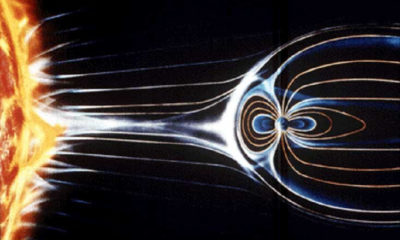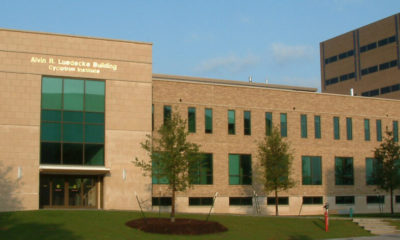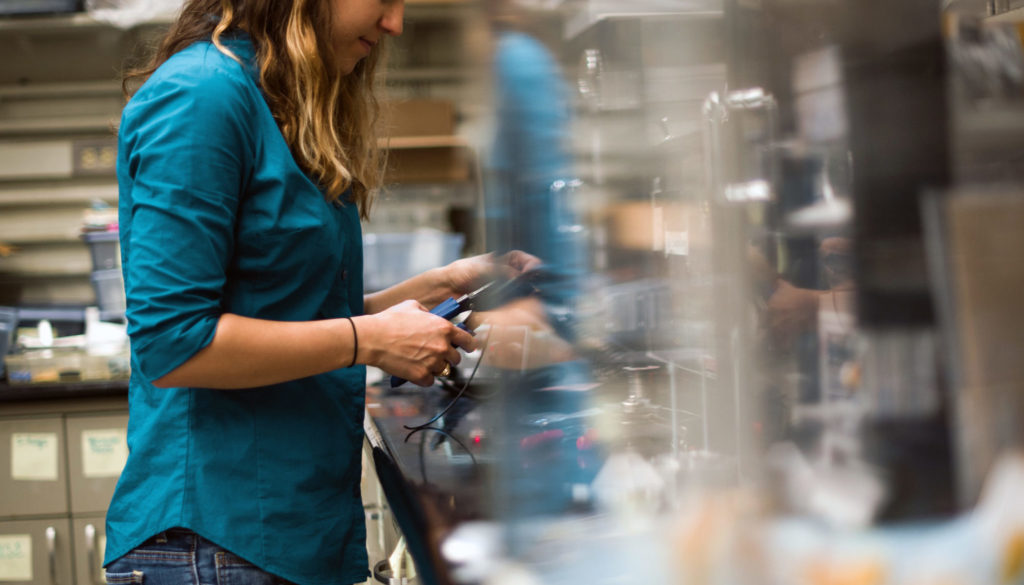Texas A&M Physics, Cyclotron Institute Team With NASA to Offer New Master’s Degree
One of the biggest challenges organizations face among the many potential hazards they encounter when sending humans and aerospace systems traveling through the endless reaches of the cosmos is the harsh radiation environment. All it takes is a single rogue particle to wreak havoc on the electronic components of a spacecraft with potentially catastrophic results.
To help ensure the success of future space missions and the safety of spacecraft and both the astronauts and scientists who rely on them, Texas A&M University is teaming up with NASA and the Jet Propulsion Laboratory in a first-of-its-kind partnership aimed at training the next-generation workforce in the rapidly growing field of space radiation effects testing.

With input from NASA and working through the Department of Physics and Astronomy, the Cyclotron Institute is offering a new graduate degree — a Master of Science in Applied Physics with an emphasis in space radiation effects. Students in the two-year program launched earlier this fall will learn to design and interpret tests on the ability of spacecraft hardware and electronics to withstand high-energy radiation before ever leaving the Earth’s atmosphere.
“The Cyclotron has for 20 years served as a facility to carry out space radiation effects testing, but we’ve never had an educational program to fulfill the workforce,” said Texas A&M Regents Professor of Chemistry and Cyclotron Institute Director Dr. Sherry J. Yennello. “We decided that was something we needed to do for the nation — design a program with NASA to help fulfill that workforce need.”
Students admitted into the new master’s program will take physics, engineering and computer science courses to build a solid foundation in the methodologies of particle physics that underpin the key concepts of radiation testing. The hallmark of the curriculum will be hands-on research experience and the opportunity to work alongside practitioners in the field of space radiation effects.

At the end of their first year in the program, students will have the opportunity to participate in a semester-long internship with NASA or other program-affiliated partners. For their capstone research coursework, students will get to collaborate on actual experimentation with NASA or another designated agency at the Cyclotron Institute’s Radiation Effects Facility The students will be assigned a project in which they’ll get to design and conduct testing on a live accelerator beam under the supervision of a designated mentor.
“There are programs at other institutions where people can learn about space radiation effects, but Texas A&M has a radiation effects testing facility to provide a hands-on component to that degree,” Yennello said. “What we have to offer is both the academics and the actual real-world experience, working side by side with current practitioners in the field.”
Students will have additional opportunities to connect with professionals during biannual boot camps in space radiation effects. These boot camps will invite select researchers from industry to the Cyclotron Institute for three-day training courses in space radiation effects, to be hosted initially by NASA representatives. Students in the master’s program, however, will also attend the boot camps as part of their course credit.
Because beam time at the Radiation Effects Facility is such a highly sought-after commodity among research-based organizations, the space industrial base and government agencies, one goal of the boot camps is to make sure clients come prepared to make the most of their time, says Dr. Henry L. Clark, an accelerator physicist and facility supervisor for the Cyclotron Institute. The other primary objective, he notes, is to instill that same preparedness in the master’s program students as they network with professionals from a host of different companies.
“The field of space radiation effects is growing fast, and hundreds of people are expected to be needed in the workforce,” Clark said. “Our collaboration with NASA is the first in the country to develop highly trained and educated people through a tight coupling or partnership between an academic department and primary radiation effects testing facility for this specific discipline.”
The increasing demand for researchers in radiation testing comes on the heels of a renewed interest in space exploration. Last May, SpaceX made history by sending veteran astronauts Bob Behnken and Doug Hurley to the International Space Station — the first crewed spacecraft launched from American soil since 2011 and the first time a private company has put humans into orbit. Prior to the Crew Dragon capsule embarking on its historic 90-day voyage, however, SpaceX brought nearly 100 of its electrical components to Texas A&M for testing at the Cyclotron Institute’s Radiation Effects Facility during a three-year period in advance preparation for its trip to space.
Unlike its predecessors, the retired Space Shuttle and Apollo spacecrafts that utilized mostly analog control systems, SpaceX’s Crew Dragon capsule is operated almost entirely via touch screen panels similar to an iPad. Although it’s a far more convenient operating system for the astronauts, Clark notes that it’s also more susceptible to radiation exposure — in particular, single-event effects (SEE), which can occur when a single high-energy particle strikes an integrated circuit, possibly resulting in system corruption or even permanent damage.
“We perform a lot of applications here with our beams that are really quite interesting, but seeing the launch and knowing our cyclotron had a hand in it was really quite satisfying,” Clark said.
Although the Cyclotron Institute has been delivering beams for nuclear experimentation since 1967, its affiliation with NASA dates back to the mid-1990s when the facility first began regularly outsourcing access to its K150 and K500 cyclotrons. Since then, commercial, governmental and educational organizations from across the country have flocked to Texas A&M to study the effects of ionizing radiation on electronic systems. As one of the nation’s premiere radiation effects testing facilities, the Cyclotron Institute continues to attract major clients, including aerospace mainstays Blue Origin, Boeing and Lockheed Martin Corp.
Yennello says students wishing to begin Texas A&M’s master’s program in space radiation effects either in spring 2021 or fall 2021 may apply through Texas A&M Physics and Astronomy or contact a graduate advisor for additional information.
“This is a unique opportunity to begin a career that will always have questions needing to be answered,” Yennello said. “If you want to do something that matters, this is science that matters.”
# # # # # # # # # #
About the Cyclotron Institute: Dedicated in 1967, the Cyclotron Institute serves as the core of Texas A&M University’s accelerator-based nuclear science and technology program. Affiliated faculty members from the Department of Chemistry and the Department of Physics and Astronomy conduct nuclear physics- and chemistry-based research and radiation testing within a broad-based, globally recognized interdisciplinary platform supported by the United States Department of Energy (DOE) in conjunction with the State of Texas and the Welch Foundation. The facility is one of five DOE-designated Centers of Excellence and is home to one of only five K500 or larger superconducting cyclotrons worldwide. To learn more, visit https://cyclotron.tamu.edu/.
About Research at Texas A&M University: As one of the world’s leading research institutions, Texas A&M is at the forefront in making significant contributions to scholarship and discovery, including in science and technology. Research conducted at Texas A&M generated annual expenditures of more than $952 million in fiscal year 2019. Texas A&M ranked in the top 20 of the most recent National Science Foundation Higher Education Research and Development survey based on expenditures of more than $922 million in fiscal year 2018. Texas A&M’s research creates new knowledge that provides basic, fundamental and applied contributions resulting, in many cases, in economic benefits to the state, nation and world. To learn more, visit Research@Texas A&M.
-aTm-
Contact: Chris Jarvis, (979) 845-7246 or cjarvis@science.tamu.edu; Dr. Sherry J. Yennello, (979) 845-1411 or yennello@comp.tamu.edu; or Dr. Carl Gagliardi, (979) 845-1411 or c-gagliardi@tamu.edu
The post Texas A&M Physics, Cyclotron Institute Team With NASA to Offer New Master’s Degree appeared first on Texas A&M College of Science.
